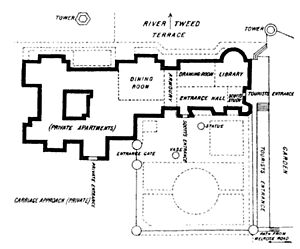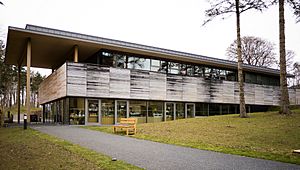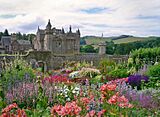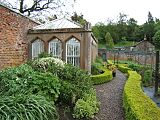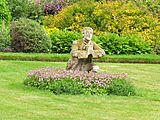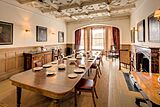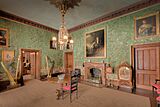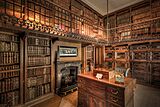Abbotsford, Scottish Borders facts for kids
Quick facts for kids Abbotsford |
|
|---|---|

Abbotsford in 1880
|
|
| Former names | Cartleyhole, Clarty Hole |
| General information | |
| Type | Baronial Mansion |
| Architectural style | Gothic Revival |
| Location | Scottish Borders |
| Address | Galashiels |
| Town or city | Near Galashiels |
| Country | Scotland |
| Coordinates | 55°35′59″N 2°46′55″W / 55.59972°N 2.78194°W |
| Renovated | 1817–1825 |
| Owner | Scott Family |
| Designations | Category A Listed Building |
Abbotsford is a famous old country house in the Scottish Borders, Scotland. It sits right by the River Tweed, close to Galashiels. This beautiful house was once the home of Sir Walter Scott, a very well-known writer of historical novels and poems. He had it built between 1817 and 1825. Today, Abbotsford is open for everyone to visit. It's also a special "Category A" Listed Building, which means it's very important historically.
Contents
The Story of Abbotsford House
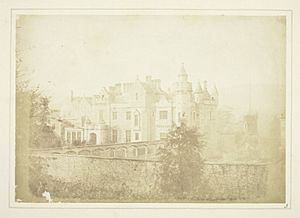
The land where Abbotsford stands was first a farm called Cartleyhole. People sometimes called it "Clarty Hole," which meant "muddy hole." Sir Walter Scott bought this farm in 1811. He then gave it a new name, "Abbotsford." This name came from a nearby ford (a shallow place to cross a river) that monks from Melrose Abbey used long ago.
Scott started by making the original farmhouse a bit bigger in 1811 and 1812. But he soon decided to make much larger changes. Big building projects happened between 1816 and 1819, and again from 1822 to 1824.
Inside this grand house, Scott collected many interesting things. He had a huge library filled with books. He also gathered old furniture, weapons, and armor. Many of these items were special relics connected to Scottish history. For example, he had the Celtic Torrs Pony-cap and Horns and the Woodwrae Stone. These are now in the Museum of Scotland.
Sir Walter Scott himself described his new home as "a sort of romance in Architecture." He also called it "a kind of Conundrum Castle." The main part of the house was finished in 1824.
Architecture and Design
The house is shaped like a rectangle, but with uneven edges. One side of the house looks out over the River Tweed. The building style is mostly Scottish Baronial. This style makes the house look like a small castle. It has little towers and fake battlements (the top parts of castle walls) decorating the house and garden walls.
Sir Walter Scott worked with architects William Atkinson and Edward Blore. Together, they helped create the Scottish Baronial style. Abbotsford is seen as a very important building that influenced many other homes in Scotland.
Scott also had historical pieces built right into the walls of the house. For example, the doorway from the old Tolbooth (a historic prison) in Edinburgh was used. He also put parts of Edinburgh's 15th-century Mercat Cross in the South Garden.
Modern Comforts and Technology
Even though Abbotsford looks old and medieval, Sir Walter Scott wanted it to be comfortable. He made sure the house had all the modern conveniences of his time. It was even a testing ground for new technologies.
The house was one of the first to have early gas lighting. It also had pneumatic bells. These bells used air pressure to connect people in different parts of the house with servants.
Abbotsford's Later Years
Just one year after enjoying his new home, in 1825, Sir Walter Scott faced financial problems. This meant the estate went into debt. However, in 1830, his creditors (the people he owed money to) gave him his library and museum collection as a gift.
Later, in 1847, a publisher named Robert Cadell helped clear all the debt on the property. He did this in exchange for the Scott family's share in the rights to Sir Walter's books.
Sir Walter Scott's only son, Walter, sadly passed away in 1847. He never got to fully enjoy the property. Abbotsford continued to be passed down through Scott's family until 2004.
The last direct descendant to own Abbotsford was Dame Jean Maxwell-Scott. She inherited it in 1998 from her older sister. The sisters worked hard to turn the house into a popular tourist attraction. They needed visitors to help pay for the house's upkeep. Abbotsford only got electricity installed in 1962!
Dame Jean was a lady-in-waiting to Princess Alice, Duchess of Gloucester. She also loved dogs and horses. One of her horses, Sir Wattie, won two silver medals at the 1988 Summer Olympics.
After Dame Jean passed away, the Abbotsford Trust was created. This trust now looks after the estate to make sure it is preserved for the future.
In 2005, there was a plan to build houses on the other side of the River Tweed from Abbotsford. Many groups, like Historic Scotland, did not agree with this plan. The development is still being discussed.
Sir Walter Scott also saved some old iron collars called "jougs" from Threave Castle. He put them on a special gateway he built at Abbotsford.
Today, Tweedbank railway station is located very close to Abbotsford, making it easy for visitors to reach.
Visitor Information
In August 2012, a new Visitor Centre opened at Abbotsford. This center has a small exhibition, a gift shop, and a café called Ochiltree's. From the café, you can enjoy views of the house and its beautiful grounds.
The house itself reopened to the public in July 2013 after a lot of important renovation work. In 2014, Abbotsford won a special award, the European Union Prize for Cultural Heritage / Europa Nostra Award, for its excellent conservation project.
- Abbotsford House exterior
- Abbotsford House interior
See also
 In Spanish: Abbotsford House para niños
In Spanish: Abbotsford House para niños


